
Dr. Elisabeth Provencher, Podiatrist and Dr. Mylène Abran, Podiatrist, both doctoral candidates in podiatry at the Université du Québec à Trois-Rivières (UQTR), are two dynamic professionals who are at your service and, above all, attentive.
Constantly on the lookout for the latest innovations in podiatric care, they count on a vast knowledge base to take care of you promptly and efficiently. Schedule an appointment within 48 hours by calling the Clinique podiatrique de Lanaudière today.
Lanaudière podiatry clinic
28 Chemin du Golf Est #402, Saint-Charles-Borromée, QC J6E 2B4
1-888 418-7340 Toll free
Tuesday : 8:30 - 17:00
Wednesday : 8:30 - 20:00
Thursday : 8:30 - 17:00
Friday : 8:30 - 15:00
An efficient and accessible clinic
Located in Saint-Charles-Borromée, in the Joliette MRC, the Clinique podiatrique de Lanaudière has made it a priority to schedule appointments within 48 hours for its patients. And time slots for emergencies are reserved on a daily basis. This gives you access to quick treatment to prevent your foot problems from getting worse.
In addition to being available to treat your pain, you are also greeted in a friendly and comfortable atmosphere. Since 2015, podiatrists Élisabeth Provencher and Mylène Abran have been offering you all the basic podiatric treatments, in addition to manual therapy and laser therapy.

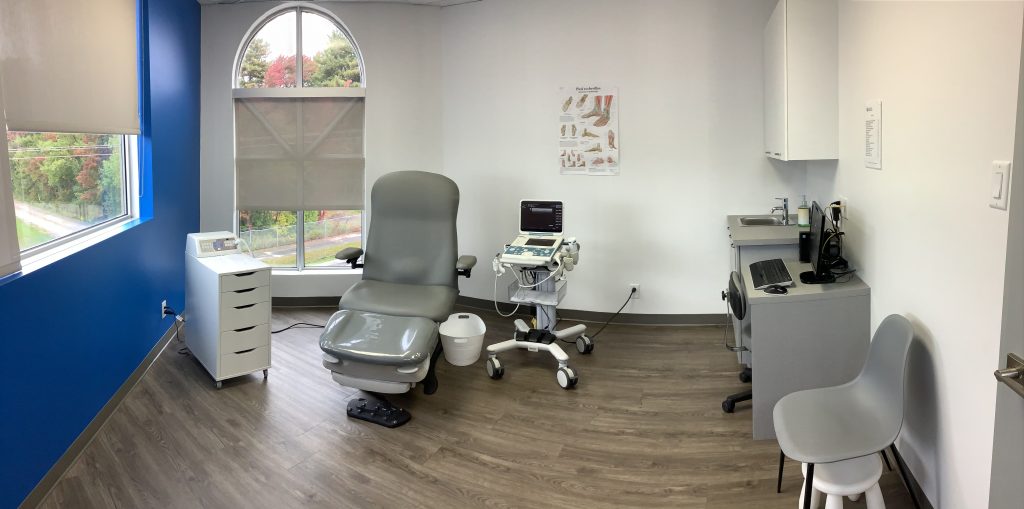
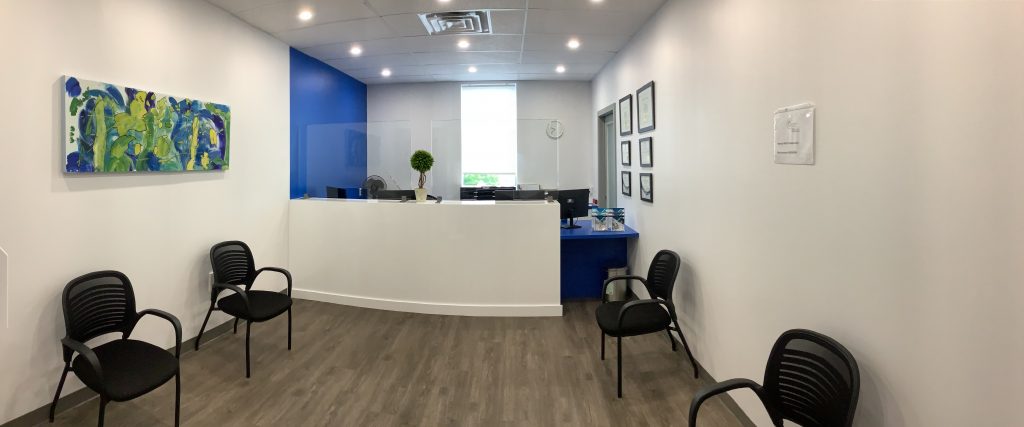
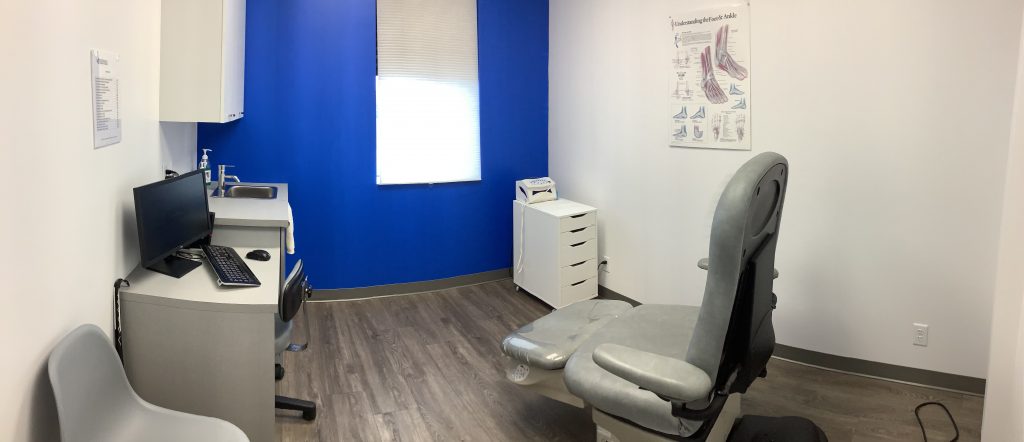
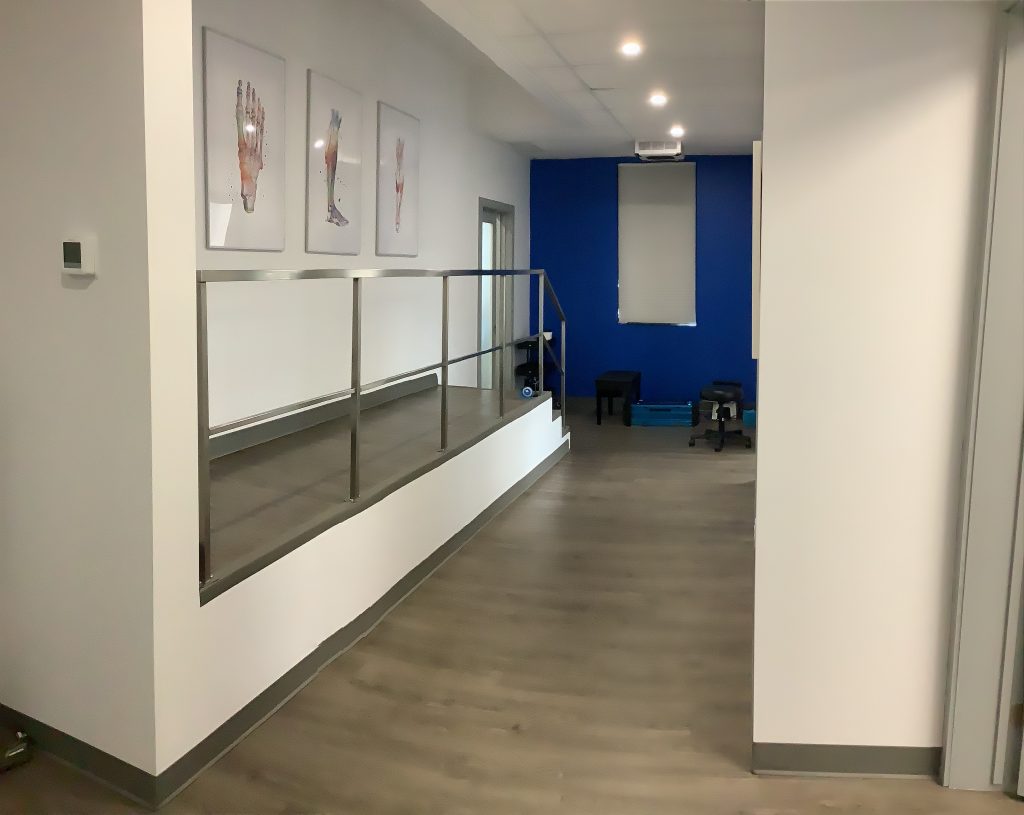
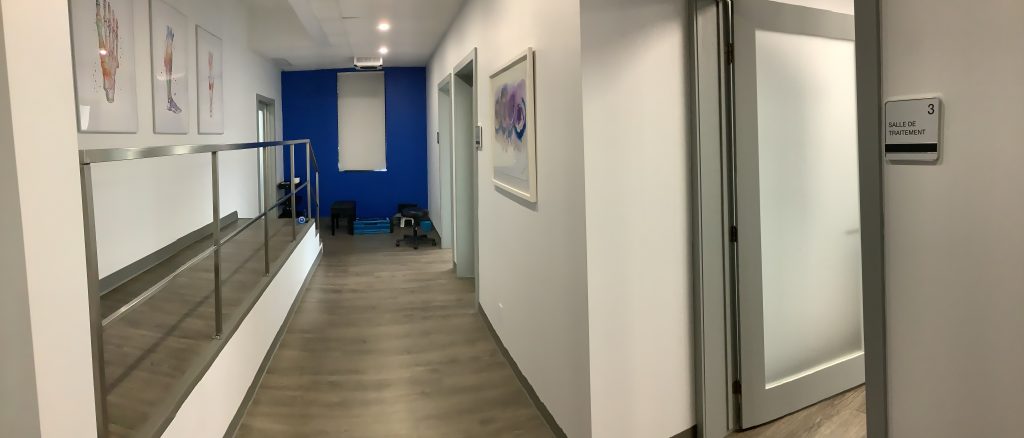
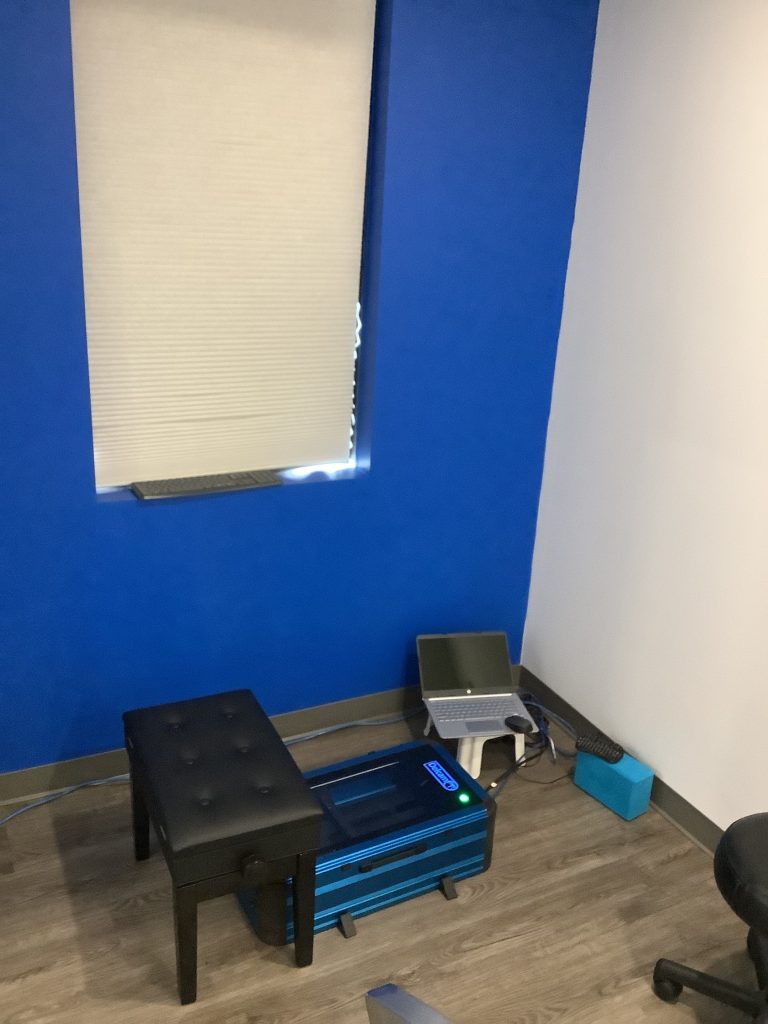
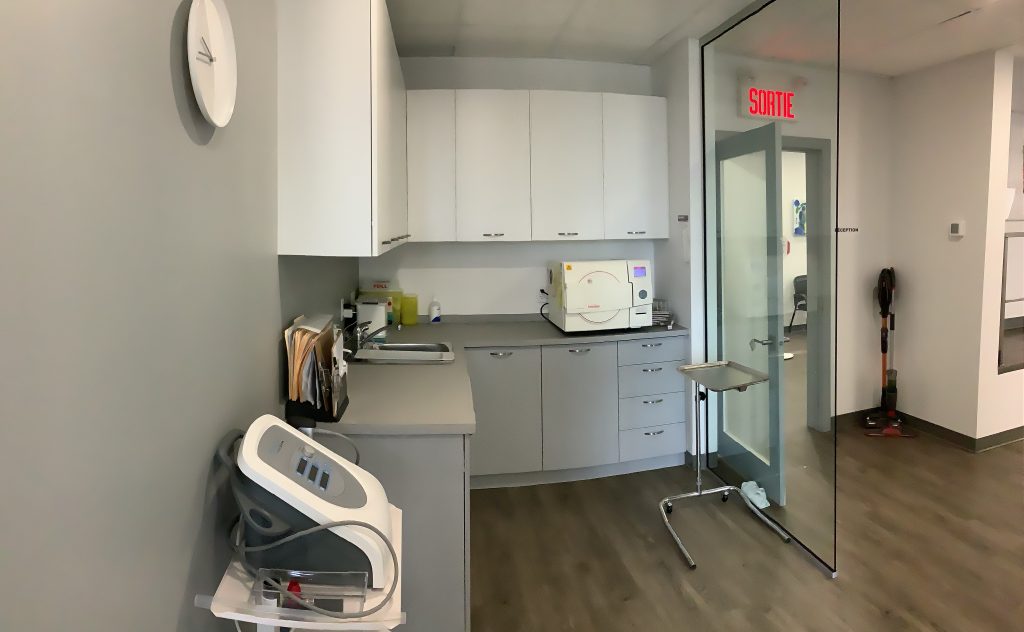

Frequent problems
- Plantar fasciitis: causes, symptoms and treatments
- Foot bunion (hallux valgus)
- Metatarsalgia
- Morton’s neuroma
- Ingrown toenail (onychocryptosis)
- Plantar warts: causes, symptoms and treatment
- Nail fungus (Onychomycosis)
- Corns, calluses and severe corns
- Heel spur (Lenoir’s thorn)
- Diabetic foot
Plantar fasciitis: causes, symptoms and treatments
Plantar fasciitis is a common foot condition. A strain or break in the plantar fascia, the fibrous band that supports the arch of the foot, is at the root of this condition.
Heel discomfort is the most prominent sign of this condition. It will be felt from the first steps in the morning or after a lengthy period of sitting.
You can find plantar fasciitis symptoms, causes, and remedies are listed below.
A person with plantar fasciitis will feel discomfort when they first walk in the morning, but it will subside over the day. They will also experience discomfort after sitting for an extended period of time.
Plantar fasciitis can also cause the following symptoms:
- Pain when palpating your arch or when pressing on your heel;
- Standing or walking causes pain, which might worsen over time;
- Tension on the outside of the foot, which can cause compensating foot and leg discomfort;
- A condition that gets...
Foot bunion (hallux valgus)
Is it difficult to walk on your foot because of a deformity in the big toe area? Is your big toe extending from the base due to the same deformity? Do you have pain and inflammation in your joints?
If this is the case, consult a podiatrist right away because you most likely have a bunion (hallux valgus).
Don't be deceived if the bunion appears to be painless at first.
Hallux valgus can produce a variety of unpleasant symptoms, ranging from minor aches and pains to ingrown toenails and mobility issues.
Here's a rundown of the signs and symptoms of a bunion:
- The appearance of a hump at the base of the big toe caused by a common joint displacement
- Beginning of the displacement of the big toe towards the 2nd toe
- Appearance of joint stiffness and pain when moving straight
- Having trouble putting on shoes (widening of the forefoot)
- Second toe deforms and becomes clawed or hammered
- Joint...
Metatarsalgia
Do you ever get a pain in the foot that makes you feel like you have needles or pebbles in your shoes? If so, you may have metatarsalgia.
This is what we call the pain in the area of the foot sole, between the arch of the foot and the toes. If you have metatarsalgia, you may experience pain in a very localized area or on your entire forefoot.
Metatarsalgia is basically caused by inflammation. Often, the patient who suffers will feel that their socks are always bunched up at the base of the toes. Sometimes they will even feel like they are walking with a pebble or needles in their shoe.
- Burning sensation at the front of the foot
- Swelling of the front part of the foot
- Swelling on the front and top of feet
- Calluses on the front part of the feet
- Difficulty crouching down on bent toes
- Twinge in the foot phalanges
Metatarsalgia can be caused by a number...
Morton’s neuroma
Do you suffer from foot pain that resembles electric shocks in the forefoot, followed by numbness in your toes? If you experience this, it can be symptoms caused by neuroma, also known as Morton’s neuroma.
This problem is due to a thickening of the nerves located between the toes, as a result of compression or friction. This leads to inflammation, numbness, burning or a sensation of small electrical discharges felt in the toes.
Although there is no outward sign of this condition, neuroma triggers several uncomfortable sensations in different areas of the foot.
- Numbness and tingling in your toes
- Sensation of burning in the forefoot
- Sensation of having a bunched up sock under your toes
- Sensation of small electrical shocks in your toes
- Toe cramps
These symptoms are aggravated if you remain standing for long periods of time or if you wear narrow shoes that are not...
Ingrown toenail (onychocryptosis)
Ingrown toenails are a frequent nail issue that can be extremely painful and even incapacitating. It's identified by a toenail that grows into the flesh and punctures it.
Ingrown toenails cause irritation and, in the worst-case scenario, infection, resulting in painful toes.
As a result, it is critical to address the problem as soon as possible in order to prevent the situation from spiralling out of control.
Let's look at the causes, symptoms, and remedies for ingrown toenails.
An ingrown toenail can be identified by a variety of symptoms. Inflammatory redness, pain when squeezed, and, in some circumstances, blood or pus on the side of your nail are all possible symptoms.
However, keep in mind that an ingrown toenail has three stages;
- First stage: there is a small inflammation and pain when pressed.
- Second stage: we observe an infection and the wound becomes more visible.
- Third stage: we...
Plantar warts: causes, symptoms and treatment
A viral infection is what causes a plantar wart, which is a skin lesion. It can either stay dormant for years or develop and spread quickly. It's a contagious skin condition that affects you and those around you.
The HPV, or human papillomavirus, creates these lesions. Despite the fact that it is a harmless virus, it is recommended that you get treatment as soon as possible to get rid of it.
The plantar wart frequently appears as a tiny, rough, spherical, and flat lump. It will manifest itself in a variety of ways.
- Appearance: it consists of spongy, brownish or yellowish tissue with small black dots;
- Size: it can measure from a few millimeters to several centimeters in diameter;
- Pain: plantar warts can be painful, even though they are uncommon. Friction or a pressure point can produce this type of pain, which can become severe;
- Posture problem: the foot pain caused by the plantar wart can lead to a foot positioning...
Nail fungus (Onychomycosis)
If you suffer from a nail infection like nail fungus (onychomycosis), don’t let this problem go untreated. Most often affecting the big toe, it is a fungal infection that causes pain and that is very difficult to treat.
However, if you take the time, it is possible to get rid of it. Read on for further information on nail fungus.
Onychomycosis is a fungal infection, that is, caused by fungi. It causes different symptoms in the affected individual. The main symptoms associated with this podiatric problem include:
- Nail discoloration (it becomes white, yellow or brown)
- Nail that grows thicker, curls up or changes shape
- Nail that breaks more easily
- Painful, infected nail
- Residue under the nail
As mentioned below, it is very difficult to rid oneself of an infection like onychomycosis. So, as recommended by podiatrists, if you suffer from any of these symptoms, do not hesitate to schedule an...
Corns, calluses and severe corns
Corns, calluses and severe corns are formations of dead flesh under the feet. They can be embarrassing for people when they walk or exercise.
Often, people with delicate feet tend to suffer more. However, this foot problem is easily treated.
It is common for an individual to develop skin problems. However, it is important to know the difference between the 3 pathologies described below.
- Corn: this is a localized area of skin that thickens a lot. When a cluster forms, it bores into the skin and causes pain similar to that of a pebble in a shoe.
- Callus: a corn has several names, like callosity or hyperkeratosis. It is characterized by an accumulation of excessive layers of skin and can form cracks in the heel if not treated.
- Severe corn: these are also corns, but in their case, they are more advanced. They are painful, with a brownish center. They develop because of excessive pressure on the skin that has...
Heel spur (Lenoir’s thorn)
When you place your foot on the ground, do you feel discomfort beneath your heel?
Seeing as calcification under the calcaneus is quite common, Lenoir's thorn might be the disease that affects you.
The heel spur, known as Lenoir's thorn, is a bony protrusion on the inside of your heel. This anatomical structure can be seen by X-ray.
People with this condition frequently experience pain in their heels while taking their first steps in the morning or after sitting for a long period. They may also notice a painful spot in their heel, such as a spur.
Imaging is usually used to detect this structure. It is very difficult to feel by touch.
Let's take a look at what makes heel spurs develop, as well as the therapies that can help you get rid of the discomfort they produce.
Heel spurs usually do not cause any symptoms.
When walking or standing for lengthy periods of time, the majority of persons with this...
Diabetic foot
Diabetic foot develops as a result of the neuropathy that comes with poorly managed diabetes. When blood sugar levels are excessively high for an extended length of time, it impairs a person's neurological system.
The injury results in a lack of sensation in the lower limbs, among other things. Peripheral neuropathy is the medical term for this condition.
Blood vessel constriction is also caused by poorly managed blood sugar levels. Wounds and ulcers form more easily and heal more slowly as a result of inadequate circulation.
If left untreated, these two factors explain the dangers of a diabetic foot. A diabetic foot sufferer may have trouble recognizing a wound or a temperature change. As a result, individuals may be unable to discern between discomfort that requires the attention of a podiatrist or other health care provider.
Diabetic foot is a severe disease that can lead to gangrene and, in the worst-case scenario, amputation. That's...
Treatments provided
- Cortisone injections
- Foot ultrasound imaging
- Evaluating Children’s Feet
- Biomechanical exam
- 2D and 3D digital imaging
- Ultrasound guided injection
- Nail culture
- Therapeutic foot taping
- Foot orthotics
- ShockWave therapy
- Foot care – Nails, corns and calluses treatment
- Manual foot therapy
- Stress fracture in the foot
- Treatment of foot pain by the podiatrist
- Treating frostbite on the feet and toes
- Thick and malformed toenails
- Ingrown toenail treatment by a podiatrist
- A podiatrist’s treatment for plantar warts
- Therapeutic laser treatment
- Treatments for paronychia of the toe
Cortisone injections
Cortisone injections, sometimes referred to as “cortisone infiltration,” are often a beneficial podiatry treatment used to relieve acute or chronic pain related to various musculoskeletal issues. Actually, cortisone is a hormone frequently used as an anti-inflammatory to relieve certain joint pains, rashes, inflammation or swelling.
Learn more about cortisone injections, an effective treatment with numerous benefits, but which must generally be used in the short term, with care and discernment, by a healthcare professional.
Foot ultrasound imaging
A musculo-skeletal ultrasound of the foot is a medical imaging technique used to examine pathologies that affect soft tissues such as ligaments, tendons, nerves and muscles. Complementary to the clinical examination, a foot ultrasound provides an accurate diagnosis and is used to design a more structured treatment plan for patients.
A foot ultrasound is an imaging technique that does not use radiation, and is completely safe. Children, adults and seniors can all benefit from this service, regardless of their physical condition.
Easily administered, a foot ultrasound provides results almost equivalent to those of an MRI, ensuring rapid...
Evaluating Children’s Feet
Children’s bone structure remains malleable until the growth process is complete. Having your children’s feet evaluated by a competent foot care professional will ensure proper management of any foot pathology that may worsen over the years.
Thus, when taken care of early enough, it is possible to improve your child’s postural development and correct any foot issues for the rest of their lives!
Biomechanical exam
Comprehensive biomechanical examinations are carried out in a podiatric clinic in order to make an accurate diagnosis of your condition. It is thus possible to establish the best possible treatment plan. During your visit, podiatric doctors who provide advanced expertise will evaluate you.
A complete examination done in a podiatric clinic includes:
2D and 3D digital imaging
Foot digitization consists of capturing the imprint of the feet using various devices to establish an accurate diagnosis. This technique is particularly useful when it comes to designing custom-made plantar orthotics.
2D impressions are taken using a podograph. A kind of pressure-sensitive cushion, a scan or a mirror, the podograph detects and shows a perfect image of the foot's plantar surface.
On the other hand, the 3D scanning method requires the contribution of a three-dimensional sensor. It can accurately reproduce the entire morphology of the foot.
These scanning methods make it possible to conceptualize the foot and determine the source of discomfort extremely rapidly.
For the podiatrist, taking an imprint is both a diagnostic measure and a solution for creating highly sophisticated foot orthotics.
In addition to creating high-precision orthotics, foot scanning plays a key role in understanding postural...
Ultrasound guided injection
Ultrasound-guided injection can be used to deliver treatment directly to the affected area.
It may contain an anti-inflammatory solution, similar to the cortisone injection in the foot.
Ultrasound-guided injections, however, are more typically utilized to guide a medical practitioner during surgery on minor foot structures.
This type of infiltration not only relieves pain in pathologies including osteoarthritis of the big toe, plantar fasciitis, Morton's neuroma, and other plantar ailments, but it also allows for viscosupplementation and hyaluronic acid injection into particular joints.
This treatment offers pain alleviation that is both effective and safe.
Discover what makes this modern process unique, as well as how it can be beneficial for you.
Podiatrists can work safely and efficiently with ultrasound injection.
Although such a guiding device is occasionally required for cortisone injection in the...
Nail culture
Nail culture consists of taking nail and skin fragments from under a nail that appears to be affected by a fungus.
The main purpose of this procedure is to rule out a diagnosis of various pathologies comparable to fungal toenail disease.
Examples include eczema or psoriasis, which may have similar symptoms but do not require the same treatment as onychomycosis.
Minimally invasive, nail culture has many benefits.
One of these is to facilitate the detection of a fungal foot infection that is difficult to treat if not treated early.
Learn how nail culture fits into the podiatrist's arsenal of diagnostic tools and how it can help in selecting the right treatment for you.
Some symptoms of nail fungus are similar to other skin infections such as psoriasis and eczema when left untreated.
The following symptoms are similar to those of nail fungus and are sometimes observed in patients with...
Therapeutic foot taping
Therapeutic taping consists of adhesive bandage that is strategically applied to specific areas in order to increase muscle tone or reduce pain associated with certain movements.
Contrary to popular belief, therapeutic taping helps more than just for athletes.
While its use is widespread among runners and tennis players, therapeutic taping is also suitable for the general population.
It is efficient for relieving very specific joint and muscle pain, however therapeutic taping cannot be applied just anywhere at random.
That's why it's important to trust a qualified professional such as a podiatrist to perform the taping.
If you have been struggling with muscle pain or tension for some time, therapeutic taping may be right for you.
Taping is often used in addition to physiotherapy and plays a therapeutic role for many people.
This comes in 3 types: athletic taping, neuro-proprioceptive taping and finally...
Foot orthotics
The primary goal of plantar orthotics is to improve the function of your foot in order to correct various biomechanical flaws or posture issues. They are used to compensate for certain deficiencies in your foot. Because they are custom designed specifically for your condition, the orthosis is perfectly adapted to the shape of your foot to optimize its function.
In addition to relieving any pain you may experience, a custom-made foot orthosis is adapted to the morphology of your feet, and redistributes the pressure exerted on them. It can therefore be used to treat many pathologies and deformities. Remember that the health of your feet is important to be able to perform your daily activities.
To ensure your orthotics treatment provides effective results, the podiatrist will have to evaluate you and design a custom casting of your feet. You will be cared for during all stages of the process, to ensure you receive the correct orthosis, which you can...
ShockWave therapy
ShockWave therapy was first used to break up kidney stones.
This therapeutic technology, however, has been adapted to other medicinal purposes as well. Nowadays, podiatrists use it in the clinic to treat difficult-to-repair musculoskeletal injuries.Acoustic waves are at the core of the ShockWave therapy. Through a sequence of high-speed shocks, it strengthens the body and aids in the recovery of painful foot disorders. Most notably, it is used to treat plantar fasciitis, Achilles tendinitis, and heel spur.
In the case of ShockWave therapy, the podiatrist treats plantar conditions with a special device that includes an applicator.
When the applicator emits a high-intensity pulse, it is transmitted through the skin to the tissue that requires treatment.
By inducing microtrauma around the affected region, this technique aims to cause an inflammatory response in the body.
While it may appear counterproductive, it is a powerful...
Foot care – Nails, corns and calluses treatment
Performed by a podiatrist, foot care includes many treatments and assessments aimed at preventing pain, reducing restrictions and promoting comfort. They can even be performed at home by a specialized caregiver.
A versatile professional, the podiatrist uses a variety of treatments to the benefit of your feet:
- Physical treatments;
- Pharmacological treatments;
- Orthopedic treatments;
- Surgical treatments.
A number of cases require foot care to be performed in a professional clinic. Therefore, the podiatrist and their team can provide you with a complete service to prevent and treat your foot pathologies. Naturally, all of this is done with clean, sterilized equipment.
Read on to learn more about the different treatment options.
Among the common foot treatments performed in podiatry you can find:
- The application of special creams;
- The prescription of medicines;
- Foot...
Manual foot therapy
Podiatrists are trained to perform foot mobilizations. They are able to perform an articular evaluation of your feet as well as any symptoms felt. Following this evaluation, the podiatrist designs a personalized treatment plan to improve the articular architecture of your feet.
The podiatrist performs gentle and precise foot manipulations to help improve your feet’s functioning and alleviate your pain. You will thus benefit from optimal biomechanics. Your feet will be better adapted to your daily activities: walking, running, golf, etc.
Stress fracture in the foot
A stress fracture in the foot doesn't happen due to a single trauma, unlike a normal fracture.
Instead, it occurs in response to multiple repeated small stresses to the same bone in the foot.
While painful, this foot injury is particularly difficult to spot.
Therefore, to avoid unintentionally aggravating it, it is important to know how to recognize the symptoms and how to medically treat a stress fracture.
Read on to learn more about the stress fracture in the foot.
Predominantly found in athletes, stress fractures are usually located in the heel or midfoot.
Stress fracture in the heel: This part of the foot is instrumental in absorbing shock during stride. Therefore, it is not surprising that runners experience stress fractures in the heel.
However, the symptoms of a heel fracture can be similar to other foot problems such as:
- Talalgia
- Plantar fasciitis
- Heel...
Treatment of foot pain by the podiatrist
Foot pain can appear in many ways and cause many accompanying symptoms every day.
Thanks to the high level of the podiatrist's expertise, however, you can count on treatment that is completely customized to your needs and condition. These professionals possess the latest technology to treat your pain quickly and accurately.
It is the podiatrist's duty to keep up with the latest intervention techniques to get rid of your foot pain. Thanks to their continuous training, you can be sure that your feet are in good hands.
Discover the most important treatments that podiatrists use every day to remedy foot pain.
Thanks to technological advances in the world of podiatry, patients can rely on a completely safe and effective method of treating joint, tendon or ligament problems: ultrasound-guided injection.
Unlike in the past, when injections were performed rather crudely, this type of ultrasound procedure helps the podiatrist to act...
Treating frostbite on the feet and toes
Often linked to mountain climbing and other winter activities, frostbite can also occur in anyone exposed to the cold.
Of course, most Quebecers naturally anticipate the onset of winter with some exasperation, but many have no clue about the extent of the damage frostbite can cause.
The extremities of the body are particularly susceptible to drastic drops in temperature, therefore special attention should be paid to the feet.
Read on to learn about medical treatments for frostbite on the toes and feet.
Frostbite, as a true cold burn, is usually treated according to the severity of the lesions it causes.
Two types are generally distinguished: superficial frostbite and deep frostbite.
Superficial frostbite results in redness and the appearance of small blisters on the skin.
Deep frostbite, on the other hand, numbs the skin and paves the way for more damaging lesions such as the death of...
Thick and malformed toenails
Toenails that become thick, hardened, misshapen, or even yellowed as a result of moisture or traumatic injury can affect anyone.
To help with this type of inconvenience, several treatment options are available to the patient.
If you're dealing with deformed nails, dystrophy, or onycholysis, podiatrists will help you get to the root of the issue.
Let's look into some of the treatment choices for thick, misshapen nails.
The term "toenail deformity" refers to a change in the shape of the toenails as a result of trauma or infection.
Toenail dystrophy, on the other hand, has to do with texture changes.
The deformations of the toenails are caused by a variety of factors.
We may consider, for example:
- Fungal infections, like nail fungus
- Trauma of the nail plate, by crushing or cutting
- Shock trauma to the nail matrix
- Poor healing after shock
- Fractures or infections...
Ingrown toenail treatment by a podiatrist
An ingrown toenail (onychocryptosis) is an inflammation caused by a portion of a nail (usually on the big toe) penetrating the surrounding skin.
While usually minor, it is nonetheless a common nail problem that can result in pain and inconvenience in your daily life. If the ingrown toenail is not treated, it may lead to inflammation and exacerbate the pain in the foot.
Do not worry, however, as there are a variety of useful therapies available to help you get rid of ingrown toenails and get your feet back on track. Learn more in this article.
Medical nail clipping is one of the most traditional nail care procedures. Nail clipping is a common solution for ingrown toenail problems that is performed by a podiatrist or a specialized nurse (assistant). Professionals in the field of foot care can customize a cut to your nail's condition.
Nail care, on the other hand, is more than simple nail trimming, as antibiotic creams or baths can...
A podiatrist’s treatment for plantar warts
Plantar warts are common skin lesions that can be quite unsightly. They are often harmless, although they can be infectious and unpleasant.
In reality, these growths on the foot might cause bleeding or create other issues such as irritation, pain, or infectious cellulitis in the long run.
Furthermore, if you are diabetic, elderly, or immunosuppressed, your plantar warts are more likely to cause problems.
Fortunately, plantar warts may be treated in a variety of ways to reduce the risk of infection and consequences. Let's have a look at those.
Your podiatrist can write you a prescription for painless wart treatment at home. The majority of these medicines are used topically.
Prescription medication care can:
- Treat plantar warts at home;
- Treat plantar warts completely painlessly.
However, this type of treatment...
- Is usually longer lasting;
- Must be flawlessly...
Therapeutic laser treatment
Minimally invasive and highly effective, the therapeutic laser is a modern treatment for foot pain.
The laser treatment performed in the clinic relies on technology that thoroughly heals the damaged tissue through photobiomodulation.
This method accelerates the body's natural healing process, similarly to ShockWave therapy.
The therapeutic laser treatment provides relief from chronic pain, acute pain as well as post-surgery complaints.
This treatment uses safe beams of light, also known as high-power laser therapy.
When these light beams hit the skin, they penetrate the structures at the surface. Adding slight pressure may also allow the laser to reach deeper into the affected tissues.
Once they have penetrated the epidermis, the beams of radiation that reach the tissue are absorbed by melanin and hemoglobin.
As a result, the patient feels almost immediate relief when this energetic phenomenon is then...
Treatments for paronychia of the toe
Much like the ingrown nail, paronychia involves inflammation or infection of the cuticle of a toenail.
The inflammation of the skin around the affected nail is often caused by the bacterium Candida albicans (candidiasis thrush).
This results in a throbbing pain, redness and swelling of the affected toe.
If left untreated, this condition can eventually lead to pus accumulation and infection that spreads further to the toe or even the foot.
Learn more about the medical treatments for paronychia available at podiatry clinics.
As mentioned earlier, when the foot contacts a candidiasis-like bacteria, it can develop an infection of the cuticle.
As a result, this infection can lead to the accumulation of pus under the top layer of skin.
In this case, the podiatrist may suggest treating the purulent area with drainage.
Usually drainage of the subungual abscess happens as follows:
Dr. Élisabeth Provencher podiatrist
For over 5 years, podiatrist Dr. Élisabeth Provencher has been treating a wide range of foot problems. She is a member of the Lanaudière podiatry clinic team and also attends the Mascouche podiatry clinic on a regular basis.
Despite her busy schedule, Élisabeth Provencher, DPM, ensures that her patients receive cutting-edge therapies that are tailored to their specific requirements.
Training that improves therapeutic interventions
Dr. Provencher, like her podiatric colleagues, graduated from the UQTR with a doctorate in podiatric medicine. She also had to finish a term at the prestigious New York College of Podiatric Medicine as part of her academic program.
Dr. Provencher, podiatrist, has undergone manual foot therapy (TTIP) training in order to expand her field of podiatry knowledge.
In addition, she has broadened the scope of her therapeutic treatments by earning a certificate in foot ultrasonography.
With this expertise, it’s not surprising that the podiatrist sees a wide range of patients.
She is called upon to treat children, the elderly, athletes, and victims of traffic and industrial accidents in addition to her usual treatments.
A devoted and enthusiastic podiatrist
Dr. Provencher, podiatrist, is enthusiastic about her position as a podiatrist and practices it with passion.
During her early years of practice, the practitioner took part in a number of public awareness campaigns, including giving free talks at CHSLDs.
Podiatrist Dr. Élisabeth Provencher is deserving of her praise and she knows how to make each of her interventions more personalized for her patients.
Dr. Mylène Abran podiatrist
Dr. Mylène Abran has been a practicing podiatrist for 4 years now. In 2015, as she co-founded the Lanaudière podiatry clinic, Dr. Abran simultaneously practiced in Shawinigan alongside podiatrist Dr. Geneviève Champagne. Having relocated to Joliette since then, her services focus on providing appropriate foot care for all types of patients.
More than suitable qualifications
Dr. Abran pursued her studies in the podiatric medicine program at the University of Quebec in Trois-Rivières, just like her colleague. During the final months of her education, she had the opportunity to take part in an internship at the New York College of Podiatric Medicine.
Eager to provide her patients with the most comprehensive care possible, podiatrist Dr. Abran has made a point of complementing her aptitudes with additional qualifications. As such, she holds a certificate in foot ultrasound, in addition to her radiology license acquired in 2015.
Obtained last April, this qualification allows her to perform medical procedures such as:
- Ultrasound-guided cortisone injections;
- Identifying the source of soft tissue pain in lower extremities;
- Pathological diagnosis or the exclusion of other conditions.
Along with her certification in foot ultrasound, podiatrist Dr. Abran is also authorized to administer manual foot therapy, athletic taping and laser therapy.
The combination of her experiences and her qualifications is what makes podiatrist Mylène Abran a top-notch practitioner for treating all kinds of plantar disorders.
A podiatrist dedicated to her clients’ best comfort
Dr. Abran is a practitioner who is dedicated to her mission as a podiatrist, in which she generously invests her time. With a constant drive for excellence, she diligently examines and listens to her patients, then cares for them with an infallible professional passion from the very start.
Dr. Abran’s clinical work showcases her attentive nature and deep understanding of her patients’ needs. If you seek a truly personalized treatment, she welcomes you to her podiatric clinic in Joliette.
MAKE AN APPOINTMENT
Responsible for personal information/confidentiality: Suzie Cloutier
Request an appointment at the clinic
Leave us your contact details and availability and we will contact you to make an appointment.



